

Inquiry-Based Learning. Fostering a Culture of Inquiry. How can we apply literary elements and work with local experts to create high-quality graphic novels?
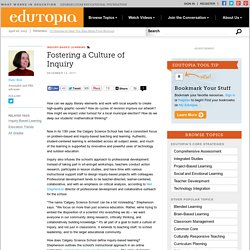
How do cycles of revision improve our artwork? How might we impact voter turnout for a local municipal election? How do we deep our students' mathematical thinking? Now in its 13th year, the Calgary Science School has had a consistent focus on problem-based and inquiry-based teaching and learning. Authentic, student-centered learning is embedded across all subject areas, and much of the learning is supported by innovative and powerful uses of technology and outdoor education.
Inquiry also infuses the school's approach to professional development. "The name 'Calgary Science School' can be a bit misleading," Stephenson says. Curiosity: The Force Within a Hungry Mind. What makes children want to learn?
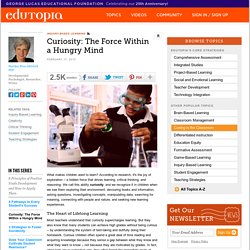
According to research, it's the joy of exploration -- a hidden force that drives learning, critical thinking, and reasoning. We call this ability curiosity, and we recognize it in children when we see them exploring their environment, devouring books and information, asking questions, investigating concepts, manipulating data, searching for meaning, connecting with people and nature, and seeking new learning experiences. The Heart of Lifelong Learning Most teachers understand that curiosity supercharges learning. But they also know that many students can achieve high grades without being curious -- by understanding the system of test-taking and dutifully doing their homework. Why Curiosity Enhances Learning. "The important thing is not to stop questioning.
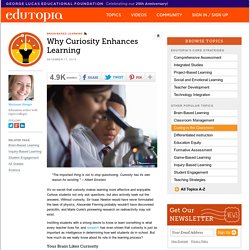
Curiosity has its own reason for existing. " -- Albert Einstein It's no secret that curiosity makes learning more effective and enjoyable. Curious students not only ask questions, but also actively seek out the answers. Without curiosity, Sir Isaac Newton would have never formulated the laws of physics, Alexander Fleming probably wouldn't have discovered penicillin, and Marie Curie's pioneering research on radioactivity may not exist.
Questions Before Answers: What Drives a Great Lesson? Recently, I was looking through my bookshelves and discovered an entire shelf of instruction books that came with software I had previously purchased.
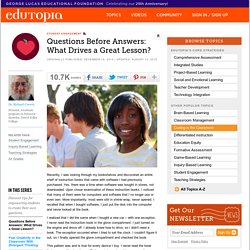
Yes, there was a time when software was bought in stores, not downloaded. Upon closer examination of these instruction books, I noticed that many of them were for computers and software that I no longer use or even own. More importantly, most were still in shrink-wrap, never opened. I recalled that when I bought software, I just put the disk into the computer and never looked at the book. I realized that I did the same when I bought a new car -- with one exception.
This pattern was and is true for every device I buy. The Need to Know Too many classrooms ignore this basic learning model. Lessons, units, and topics are more motivating when they begin with a question whose answer students want to know. 5 Ways to Help Your Students Become Better Questioners.
The humble question is an indispensable tool: the spade that helps us dig for truth, or the flashlight that illuminates surrounding darkness.
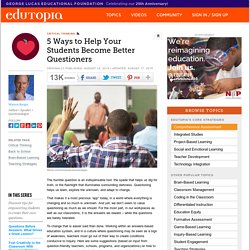
Questioning helps us learn, explore the unknown, and adapt to change. That makes it a most precious “app” today, in a world where everything is changing and so much is unknown. And yet, we don’t seem to value questioning as much as we should. For the most part, in our workplaces as well as our classrooms, it is the answers we reward -- while the questions are barely tolerated. To change that is easier said than done. Who Wants to Know? Use Student Questions to Drive Learning. Martin Luther King, Jr. considered this to be life's most persistent and urgent question: "What are you doing for others?
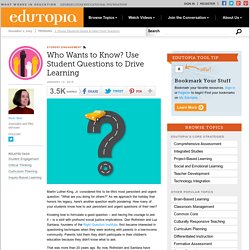
" As we approach the holiday that honors his legacy, here's another question worth pondering: How many of your students know how to ask persistent and urgent questions of their own? Knowing how to formulate a good question -- and having the courage to ask it -- is a skill with profound social justice implications. Dan Rothstein and Luz Santana, founders of the Right Question Institute, first became interested in questioning techniques when they were working with parents in a low-income community.
Parents told them they didn't participate in their children's education because they didn't know what to ask. That was more than 20 years ago. TWT: Inquiry-based Learning Strategy. Teaching and Learning for a Sustainable Future. Introduction The development of thinking and problem solving skills is an important objective of Education for Sustainable Development, especially given the urgency of problems facing the world today.
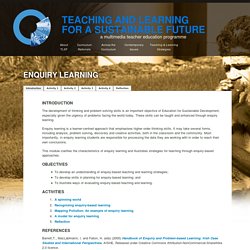
These skills can be taught and enhanced through enquiry learning. Enquiry learning is a learner-centred approach that emphasises higher order thinking skills. It may take several forms, including analysis, problem solving, discovery and creative activities, both in the classroom and the community. Most importantly, in enquiry learning students are responsible for processing the data they are working with in order to reach their own conclusions. Inquiry-based Learning - About Us. 4 Phases of Inquiry-Based Learning: A Guide For Teachers.
According to Indiana University Bloomington, Inquiry-based learning is an “instructional model that centers learning on a solving a particular problem or answering a central question.
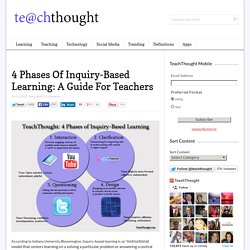
There are several different inquiry-based learning models, but most have several general elements in common: Learning focuses around a meaningful, ill-structured problem that demands consideration of diverse perspectivesAcademic content-learning occurs as a natural part of the process as students work towards finding solutionsLearners, working collaboratively, assume an active role in the learning processTeachers provide learners with learning supports and rich multiple media sources of information to assist students in successfully finding solutionsLearners share and defend solutions publicly in some manner” The process itself can be broken down into stages, or phases, that help teachers frame instruction. 4 Phases of Inquiry-Based Learning: A Guide For Teachers 1. Student-to-material. 2. 3. 4.
How Inquiry Can Enable Students to Become Modern Day de Tocquevilles. Some teachers are skeptical about “student-driven learning,” suspecting that it’s really just another chance for unfocused social time.

It can often be hard to see behind the jargon the careful planning and teacher support necessary to ensure that students not only stay focused, but also produce high-level work. Educators often wonder how students can all be working on different projects but acquiring the same skills. It may seem challenging to keep track of 30 kids investigating 30 different issues, but when inquiry-based teaching is done well, that chaotic swirl of ideas and needs is based on a strong foundation of planning. The Inquiry Process, Step By Step. How to Trigger Students’ Inquiry Through Projects. By Jane Krauss and Suzie Boss Excerpt from Thinking Through Project-Based Learning: Guiding Deeper Inquiry, published by Corwin, 2013.
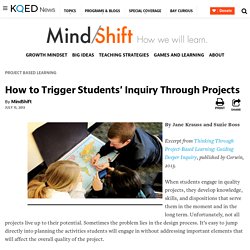
When students engage in quality projects, they develop knowledge, skills, and dispositions that serve them in the moment and in the long term. Unfortunately, not all projects live up to their potential. Sometimes the problem lies in the design process. It’s easy to jump directly into planning the activities students will engage in without addressing important elements that will affect the overall quality of the project. With more intentional planning, we can design projects that get at the universal themes that have explicit value to our students and to others. There are several ways to start designing projects. We have condensed the project design process into six steps. Reinventing School From the Ground Up For Inquiry Learning. By Thom Markham A grave miscalculation exists in the minds of many educators: That inquiry-based learning, project based learning, and 21st century competencies can flourish in industrial model schools.
Under this world view, the inquiry goals of the Common Core State Standards are “strategies” to be added to the existing list of classroom techniques, while skills like collaboration, communication, or creativity can be taught despite 43-minute periods, desks in rows, and pacing guides set in stone. In other words, reaching the top of Bloom’s Taxonomy is important, but less so than maintaining regimental order. But what we know—from industry and neuroscience—is that organizational structure, environment, and human performance are deeply intertwined.
It is inevitable that schools must be completely redesigned if society wants to tap the wellsprings of creativity and exploration that the industrial system subdues. This redesign issue looms large. The Challenges and Realities of Inquiry-Based Learning. By Thom Markham Teachers in a rural southeast Michigan high school were recently discussing the odd behavior of the senior class.
It seems the 12th graders were acting more civilly toward the junior class in the hallways. The prom was also quieter and more well-mannered than in previous years. Do You have the Personality To Be an Inquiry-Based Teacher? By Thom Markham So far, the challenges of transforming education into a system capable of inspiring students to become skillful, creative, knowledgeable problem-solvers fall into familiar territory: What types of curriculum, standards, skills, strategies, and adaptations to classroom teaching methods will be necessary to do this? But it’s likely these will prove to be secondary questions. Why Inquiry Learning is Worth the Trouble. Nearly seven years after first opening its doors, the Science Leadership Academy public magnet high school* in Philadelphia and its inquiry-based approach to learning have become a national model for the kinds of reforms educators strive towards. But in a talk this past weekend at EduCon 2.5, the school’s sixth-annual conference devoted to sharing its story and spreading its techniques, Founding Principal Chris Lehmann insisted that replicating his schools approach required difficult tradeoffs.
“This is not easy. This is not perfect,” Lehmann told a crowd of devotees stuffed inside one of the Center City school’s second-floor science classrooms on Sunday. Creating Classrooms We Need: 8 Ways Into Inquiry Learning. Reading Comprehension and Considerate Text, Teaching Today, Glencoe Online. What is IBL? - The Academy of Inquiry Based Learning. Inquiry-Based Learning (IBL) is a student-centered method of teaching Mathematics. At the college mathematics level one of the forms of IBL is the Modified Moore Method, named after R. Teaching as inquiry / Teachers as learners: Inquiry / Case studies / Curriculum stories. What is Inquiry-Based Learning? Intro to Inquiry Learning. A (Somewhat) New Approach to Educating and Inspiring Kids.
What is Inquiry Based Learning? How to Study Help students learn to study well. We offer a number of great resources. View Study Skills. What is Inquiry? Inquiry Based Learning. Effective inquiry is more than just asking questions. Introduction. Inquiry-based Learning: Explanation.